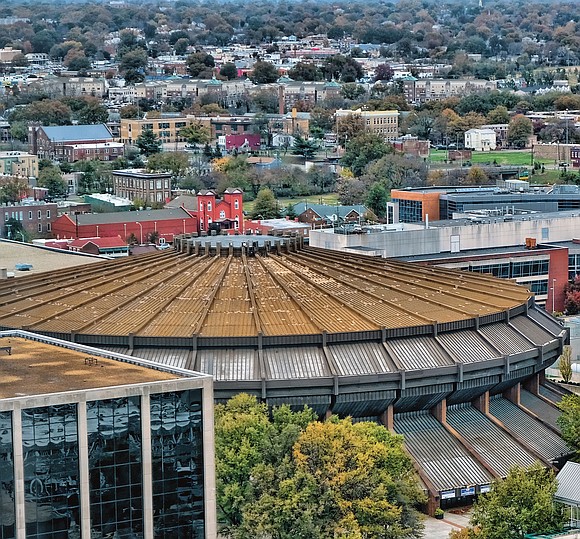Moving on up or out? Mayor Stoney submits to City Council $1.5B Coliseum replacement and Downtown development plan
Jeremy M. Lazarus | 8/9/2019, 6 a.m.
Five months ago, Mayor Levar M. Stoney was singing the revenue blues as he introduced his latest budget.
He told city residents that revenue was growing too slowly to keep up with the overwhelming demand for resources, and without a major increase in the property tax, the city couldn’t adequately address major challenges ranging from fixing city streets to funding public education and replacing worn-out police cars and fire trucks.
Mayor Stoney now has changed his tune as he introduces his long-awaited grand development plan for Downtown.
Taking the leap last Thursday, he essentially told city residents that the government is so wealthy that it can afford to divert millions of dollars a year in property taxes to pay for his current No. 1 priority — development of a huge 17,500-seat arena costing at least $235 million to replace the now closed Richmond Coliseum.
After nine months of virtual silence, the mayor fully unveiled the $1.5 billion plan to replace the Coliseum and construct an array of other private developments around it, including more than 2,500 new apartments, 20 to 25 new restaurants, at least two office buildings, a modern bus terminal for GRTC and a 541- room convention hotel.
Mayor Stoney called the plan, which was modified somewhat from the proposal he embraced last November, a “transformational” project that would generate thousands of new jobs, create a river of new tax revenue for the city and create “a thriving city center.”
He delivered the ordinances that would make it happen to Richmond City Council at a brief special meeting Monday.
The mayor and his staff crafted the deal with the Navy Hill District Corp., a group led by Dominion Energy’s top executive, Thomas F. Farrell II. If the plan is approved by City Council, Navy Hill District is to manage the entire deal, including operating and maintaining the new Coliseum and spearheading the other developments.
The target area for the develop- ment includes eight blocks in the area bounded by Leigh, Marshall, 5th and 10th streets, and portions of two blocks south of Broad Street in which the city owns surface parking lots at 4th and Broad streets and 6th and Grace streets.
While most of the plan involves private development that must find its own financing, the city must provide the money — subject to annual appropriation by the City Council — to repay the principal and interest on the $330 million that the mayor said would be borrowed to build the new Coliseum.
However, that amount that could top $600 million over 30 years, depending on the interest rate. The bond money, essentially a loan, also might include funding to pay for raising Clay and Leigh streets, which dip below grade on one side of the Coliseum, but that expense has gone unmentioned.
A financial analysis also indicates the city would need to spend $6 million to $10 million to cover additional costs, including construction of a new fire station. Under the plan sent to City Council, the Richmond Department of Social Services building would remain at 9th and Marshall streets until Navy Hill District finds another Downtown location for it. City officials have said the state would pick up the lion’s share of relocation costs for the social services department.
At this point, the John Marshall Courts Building is to remain at its current location at 9th and Clay streets. The city has not included a projected cost to replace the courts building if the circuit court judges do not accept the loss of the large parking lot that serves the building and order the city to build a new courthouse.
Critics already are calling the Navy Hill development a boondoggle rife with “sweetheart deals” for favored supporters and that it is built — like the Washington NFL team’s Richmond training camp — on exaggerated claims of job creation and revenues for the city.
Residents and City Council members still have months to go before the project comes up for a vote. Sometime in September, the council is expected to finish setting up a commission it has established to review the more than 1,000 pages of ordinances and other documents that the mayor presented. The commission would then have 90 days to undertake its review, meaning it could be January or February before City Council actually puts the plan on the agenda for a vote.
As presented in the plan, at least seven of the nine City Council members would have to approve the measure as spelled out in the state Constitution because the proposal calls for selling city property to either Navy Hill District or the city’s Economic Development Authority.
Residents also could have a chance to weigh in before a council vote if a referendum on the project developed by Paul Goldman, leader of the Put Schools First campaign, makes the Nov. 5 ballot.
“There’s a lot to consider,” said Councilwoman Kim B. Gray, 2nd District, who along with Councilwoman Reva M. Trammell, 8th District, pushed for the outside commission to review the plan.
“What do we need to spend and what will the benefit be? Are the numbers we are being given realistic or exaggerated?” Ms. Gray asked.
Among the key issues is the financing mechanism for the proposed new Coliseum. The mayor is calling for creation of a Tax Increment Financing District, or TIF, to pay for the Coliseum. The TIF would include the 10-block target area around the Coliseum and 70 other blocks of Downtown, bounded by 1st Street, Interstate 95, 10th Street and the Downtown Expressway.
Under the plan, a baseline would be established on the amount of taxes currently being collected, with any increase in real estate property taxes being directed into a special fund to repay the $330 million in revenue bonds that the Economic Development Authority would issue.
The fund also would receive from the smaller targeted development area increases in other city taxes, including admissions, business license and sales taxes, to be used to pay the debt on the new arena.
Virtually all of the growth in tax revenue that ordinarily would go to the general fund would be used for at least 15 years — and possibly up to 30 years — to pay off the debt for the new Coliseum. Any excess would go to the general fund, the mayor stated.
Among the proposal’s assumptions is that without the new Coliseum, there would be little to no growth in the Downtown district, even though City Council just rezoned most of that area to encourage new development. Some new projects already have been announced, while development in the Jackson Ward portion of the TIF has been advancing by leaps and bounds.
Another key issue is the city’s obligation to pay off the borrowed money for the new Coliseum to prevent a default.
Mayor Stoney and the city’s financial advisor, David Rose of Davenport & Co., have insisted that the deal is structured so the city would not be on the hook if the money in the fund proved insufficient — and that lenders would have to look elsewhere.
However, no documents have been provided to support that claim, nor were any proposed documents concerning any future bonds provided to City Council in the documents submitted by the mayor.
What is known is that on every previous deal involving revenue bonds, the city has been obliged to either guarantee that it would repay the money in order to get lenders to buy the bonds or pledge public property as collateral. Examples include the SunTrust Mortgage building in South Side and the now forgotten, but failed Broad Street Community Development Authority.
Restaurant owners in Downtown and around the city privately are expressing concern about the competition the Navy Hill District hopes to create by installing 23 to 25 restaurants as part of the development.
Another issue attracting attention is whether the city would get a fair price for the 11 parcels of city property it plans to sell to the Navy Hill District for the private developments.
Under the proposal delivered to the council, the Farrell group is to pay the city $15.8 million to buy the land where the hotel, apartments and other developments are to go. The property includes the Public Safety Building on 9th Street that currently is earmarked for a new office building for Virginia Commonwealth University, and a portion of the property where the Coliseum now sits.
That triggered concern among some council members as being too much of a give-away, noting that the City Assessor’s Office values the property at around $60 million, even though it currently is not taxable.
Councilman Parker C. Agelasto, 5th District, also noted he and his council colleagues have passed a law requiring the city to seek bids on any public property to be sold. Unless that law is waived as the mayor has proposed in the ordinances, the city would have to comply by seeking other offers.
Meanwhile, others are combing through the details of the proposal and raising concerns.
One critic, attorney and small busi- ness expert Justin Griffin who runs the “No Coliseum” website, calls the project “a house of cards.”
He points, as one example, to a projection that 792,000 people a year would buy tickets to events at the new arena that came from Chicago-based Hunden Strategic Partners, which reviewed the project for the city and its financial advisor.
“That would put Richmond among the top 10 in the world for arena attendance,” Mr. Griffin stated. “It also would be greater than the annual combined paid attendance at arenas in Baltimore, Raleigh, Charlotte and Charlottesville.”
Others are calling into question the mayor’s claims, based on estimates from Virginia Commonwealth University, that the project would create 12,500 new construction jobs and 9,000 new permanent jobs.
Even the Hunden study that painted a rosy picture of the impact indicated far smaller numbers.
Such considerations and issues are expected to be at the forefront as the proposal undergoes scrutiny.









